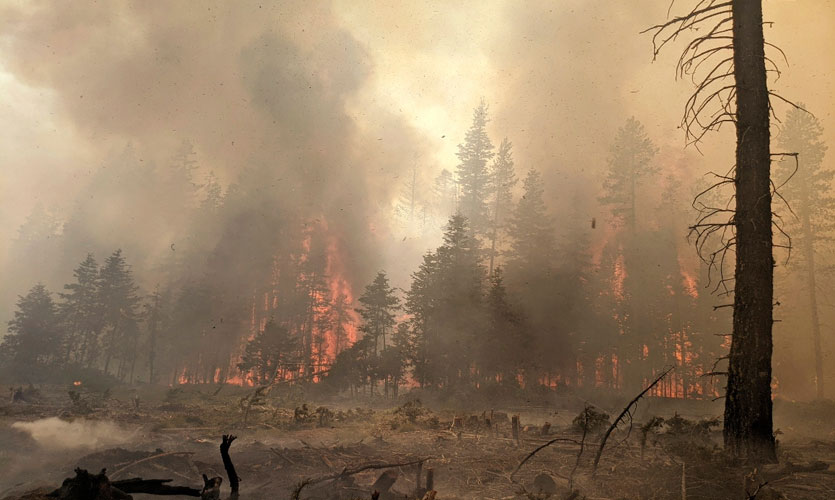Countries around the world have been plagued with wildfires causing drought, extreme heat waves, windy weather, thunderstorms and other challenging conditions. Wildfire season in the US afflicted many states throughout the nation, setting 2021 on the track to be another devastating year. The two major active fires – the Bootleg Fire in Oregon and the Colville Indian Reservation blaze in Washington – have been particularly damaging. According to the National Interactive Fire Agency, this year’s fires have blazed more than one million acres, notably worse than last year. These fires have not only torched homes and forced thousands to evacuate but have also burned through the carbon offsets bought by companies, including British Petroleum (BP) and Microsoft.
“We’ve bought forest offsets that are now burning,” Elizabeth Willmott, Microsoft’s carbon program manager, said at an event hosted by Carbon180, a non-profit focused on carbon removal.
In February, Microsoft paid Green Diamond to offset a quarter-million tons of the tech giant’s 2021 carbon emissions. However, southern Oregon’s Bootleg Fire blazed through the project, where 400,000 acres of forest owned by Green Diamond Resource Co. were preserved to compensate for greenhouse gas emissions(GHG) elsewhere. Similarly, a project that BP bought offsets from faced fires ignited by lightning in July, sweeping through the Colville Indian Reservation in Washington. The extent of the damage is still unknown, however, the fires prompted evacuations and damages to BP’s carbon offset project.
The Colville project has generated more than 14 million credits since 2016. In a transaction valued at more than $100 million, according to the Washington Department of Natural Resources, BP alone bought 13 million offsets from the Colville project.
How Do Carbon Offsets Work?
Carbon offsets act as an accounting system. For corporations, the offset scheme involves paying someone else to cut or remove a given quantity of GHG from the atmosphere as they are unable to make sufficient cuts to their actual emissions.
Carbon offset schemes can take the form of buying cleaner-burning cookstoves in developing countries to reduce deforestation for firewood or financing a wind turbine generator to displace fossil fuels. The large majority of offset schemes depend on nature-based solutions.
In the US, these are created under the designation: Improved Forest Management. Landowners need to first show that their forests can act as an above-average carbon reducer, to be considered as an offset. Once approved, they earn credit for every ton of CO2 their forests absorb. Those credits can then be sold to corporations looking to compensate for their own emissions to meet net-zero targets and achieve carbon neutrality. The company can then hold or trade the credits until they are submitted to the government for compliance purposes. Credits aren’t like traditional currency. Once declared or submitted, they are considered “retired” and cannot be used again.
The forest-based solution is a more efficient method than waiting years for financing new zero-emissions technology or infrastructure. Corporates that depend on oil sales, natural gas heating, or coal-fired furnaces can start making progress immediately through buying offsets. For example, a company could buy credits from a broker who then uses the money to help people restore a degraded coastal mangrove forest in any part of the world. An acre of mangrove trees can store up to 5-10 times as much carbon as an acre of rainforest, which works out much cheaper than upgrading industrial facilities.
“Since climate change is a global problem, it doesn’t matter where you reduce emissions,” said Anja Kollmuss, a policy analyst in Zurich who studies emissions trading. “You can reduce emissions anywhere you want and if you have a limited amount of money at your disposal, it makes sense to reduce emissions where it’s cheapest and easiest to do them.”
Read more: EU Releases Plan For The World’s First Carbon Border Tax Amidst Global Criticism
How Effective Are Carbon Offsets?
According to Mark Carney who heads The Taskforce on Scaling Voluntary Carbon Markets, the unified market for carbon offsets could be worth $100 billion by the end of the decade, up from about $300 million in 2018.
The billion-dollar carbon offsets market falls into two broad categories: voluntary and compliance. Under voluntary offsets, people and companies buy at their own discretion, whereas the compliance offsets are enforced under legally binding caps on carbon in schemes like the European Union’s Emissions Trading System.
The rising demand from customers and pressure from their own employees fuel the offset market. Till date, more than 170 companies, 77 countries and over a 100 cities have pledged to become carbon-neutral by the middle of the century or sooner.
With forestry projects prone to wildfires, drought and disease are permanent threats that are being exacerbated by global warming. The recent wildfires on the US west coast have shown the vulnerability of these offset programs. Offset initiatives consist of a “buffer” that usually make up 10 to 20 percent of a company’s credits that are not sold to anyone but are available as a kind of insurance in case of problems like environmental risks with a project. The current increased fires threaten to exhaust forest “buffer pools”, in turn raising questions about the reliability of the offset programmes.
“What we are learning is that the buffer pools are not set up in a way that anticipates the real climate risk to forest space,” Danny Cullenward, policy director at non-profit CarbonPlan, told The Independent. “It’s just early August. It’s a long road between here and the rains … we’ve got to take these risks seriously,” he said.
Environmental organisations like Greenpeace and countless critics have long slammed carbon offsets programs as PR plans or “greenwashing”. They argue that offset schemes are a way for organisations to continue the “business as usual” norms without actively cutting emissions and changing their business models. Established offset models, including the United Nations’ REDD+ program or the Kyoto Protocol’s Clean Development Mechanism have had a poor track record of overpromising and under-delivering. With the EU’s recent carbon tax efforts receiving strong criticism, similar disagreements about rules around offsets also continue to derail international climate change negotiations.
The current rising frequency of natural disasters globally requires governments, corporates and individuals to understand that the climate crisis is no longer a looming threat or a threat for the future generations alone to fight. We are living the consequences of our increased consumption and GHG emissions. The recent UN IPCC scientific report highlights that human activity is changing the climate in unprecedented and irreversible ways. The report “is a code red for humanity”, said the UN Secretary-General António Guterres.
Offsets do have the potential to combat climate change. It can channel money to much-needed parts of the planet and increase biodiversity as well as improve social equity. It needs to be an important part of the toolkit of climate solutions, however, reducing emissions is primary. Carbon offsets can buy us time, but they aren’t a ticket out of implementing hard socio-economic policies and the technical work needed to address climate change at a global scale.









